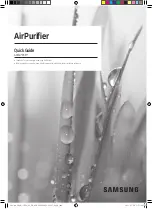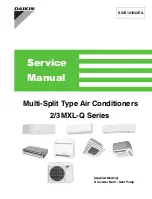
# 41718L098
Page 5
Homeowner Maintenance
Leaves and other large obstructions should be carefully
removed from the outdoor coil surfaces without damaging
the fin surface of the coil.
Routinely clean or change the indoor air filter. Should the
coil become dirty, thus restricting airflow, call a qualified
service person to carefully clean the coil surface.
Dealer Maintenance
An annual inspection by a qualified service person should
be performed to ensure continued quality performance.
Outdoor coil surfaces should be cleaned, taking care not
to damage the fin surface of the coil.
Several weep holes located in the unit base should be
inspected and cleaned, if necessary, to ensure that proper
drainage can occur.
All electrical wiring and connections should be inspected;
as should all physical connections of individual compo-
nents within the units.
Before performing maintenance operations on
system, turn off all main power switches to
indoor and outdoor units. Turn off accessory
heater power switch if applicable. Electrical
shock could cause personal injury or death.
WARNING
MAINTENANCE
START-UP
The procedure for start-up of the unit is as follows:
1.
Operate the unit for a period of at least 15 minutes to
allow for pressures and temperatures to stabilize.
Unless matched with an indoor section using an
expansion valve, the superheat method can be used
to check the system refrigerant charge. It should be
noted that this method is not accurate at low load
conditions or at outdoor ambients above 106° F.
2.
Using accurate gauges and temperature measuring
devices, determine the suction line pressure and
temperature as well as the outdoor ambient tempera-
ture.
3.
Refer to the refrigerant charging instruction label
located on the inside of the outdoor unit access panel.
Locate the intersection of the measured outdoor
temperature and suction line pressure on the chart.
4.
If the suction line temperature is higher than the
intersection temperature, the system is undercharged.
If the actual suction line temperature is lower than the
chart temperature, the system is overcharged.
Discharge Thermostat (if used)
Some models come equipped with a discharge thermostat
(loss of charge control) to guard against the compressor
overheating from loss of charge. The temperature cut out
for this control is set at 250°F, as determined by compres-
sor manufacturer’s recommendation. Discharge tem-
peratures exceeding 250°F will cause compressor oil
breakdown that will lead to premature compressor
failure. If the control trips during unit operation, a problem
exists within the system. Check for the following as
possible causes:
•
Low system charge
•
High discharge pressures
A thorough inspection of the system should be made to
determine the cause. The discharge gas temperature may
be verified by attaching an electronic type thermometer or
thermocouple to the discharge line near the control.
The control resets automatically. If the unit does not have
a discharge thermostat, an add-on kit is available.


























